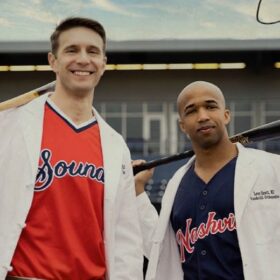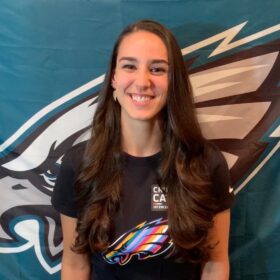Afternoon with a big leaguer
In 1985, former Negro leagues pitcher Frank McAllister was a patient at Vanderbilt Hospital and spent some time talking baseball with VUMC fans. Now the official records acknowledge what has been true all along: he was a big leaguer.
April 15, 2021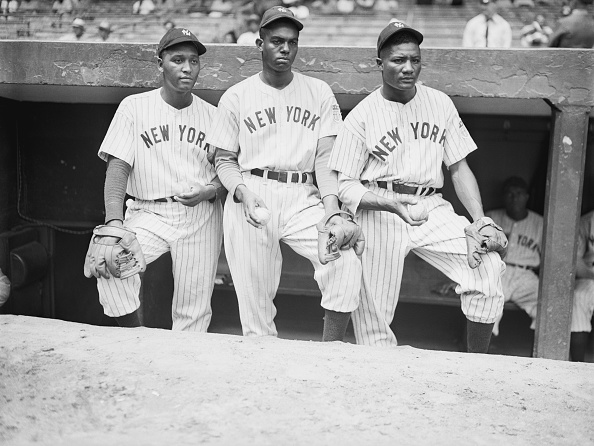
This is the photo of three pitchers that The New York Times ran in December, 2020, with the announcement that achievements from Negro league players will be included in the records of Major League Baseball. Frank McAllister, center, stands with John Stanley (left) and Gene Smith of the New York Black Yankees on the top step of the dugout — New York, July 26, 1942. Photo by Getty Images
Somebody handed Frank “Chip” McAllister a baseball and it was like the decades dropped away. His long, bony fingers, clearly the fingers of a pitcher, neatly found the proper angle on the seams. Then, he stood up from his chair in his 8 North hospital room at Vanderbilt University Adult Hospital to go through the motions of his right-handed windup. A little stiffer than he was in his playing years, but the muscle memory of how to throw the ball was still intact, even if he was wearing a blue-patterned bathrobe instead of the flannel uniform of his playing days.
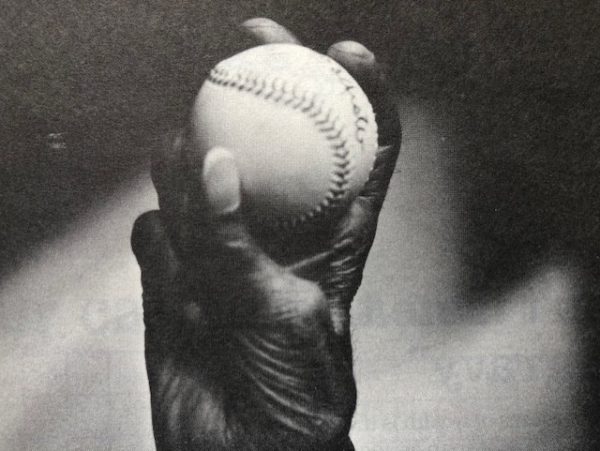
Frank McAllister demonstrates his pitching grip. VUMC file photo by Lynn DeLaney Saunders
McAllister’s playing days were in the 1930s and 1940s, but this hospital room encounter I’m remembering happened on a winter afternoon in 1985. Word spread among some VUMC baseball fans that a former Negro leagues player was in the hospital (this was pre-HIPAA, obviously). We had heard that between his scheduled medical tests McAllister might appreciate some company.
I knocked on the door of his room and he invited me in. Over the course of the next hour or so, another fan or two also came by to visit — at least one with a ball and a glove for him to sign — and we asked questions and listened.
Like many old ballplayers, McAllister remembered his playing days vividly, and his memories were polished like stones that had tumbled downstream until they were smooth and perfect.
Later I looked up some details about his life and career. McAllister was from Forrest City, Arkansas, and, after his playing days, had settled in Cairo, Illinois. He had never been a big star — he had more of journeyman’s career, playing for several teams in the Negro leagues from 1937 to 1943, including the St. Louis Stars, the Indianapolis ABCs and the New York Black Yankees.
The reason the Negro leagues existed, of course, was that in those years the major leagues did not allow Black players on its teams.
Like many old ballplayers, McAllister remembered his playing days vividly, and his memories were polished like stones that had tumbled downstream until they were smooth and perfect.
Somebody asked McAllister to describe his pitching technique. His description of his repertoire of pitches didn’t have anything fancy: “Fast ball, curve ball, drop ball.” But, he added, he was also a pretty good hitter and had some power, so at times he would play another position between his turns on the mound to keep his bat in the lineup.
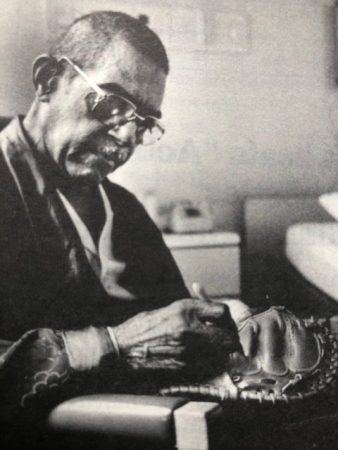
McAllister signing a glove for a fan in his Vanderbilt hospital room in 1985. VUMC file photo by Lynn DeLaney Saunders
He was happy to be playing baseball, but it was not an easy life.
“We were lucky to play half as long as we did,” he said. He spoke of hours riding on uncomfortable buses, where sleep was almost impossible. Players would climb off the bus stiff and sore from the ride. Sometimes they could go to a hotel and rest for a while, and sometimes there was time only to head to the ballpark and suit up for a game.
Many of the parks were small and run down, and some even lacked lights for night baseball. Undeterred, team owners, eyeing the larger crowds that night games could attract, would set up banks of portable temporary lights and play at night anyway.
But there was another side — when a major league team was on the road, Negro league teams would often use the vacated home park. McAllister played in legendary ballparks including Comiskey Park in Chicago, Ebbets Field in Brooklyn, and the Polo Grounds and Yankee Stadium in New York.
The experience of those parks was still with him.
“It’s a feeling to just walk out there,” he said. “All those big, pretty parks. Your knees knocking. Your teeth knocking. It feels good.”
I asked him if he ever thought back then about the unfairness of the situation that meant he and the other Negro league players never got a chance to be considered for the major leagues. How much did that weigh on them? “You got used to it,” he said. He paused, as if maybe he was thinking about saying more about that, but he didn’t.
In that era of segregation, white and Black stars would often barnstorm around the country during the offseason playing exhibition games for crowds eager to see what they couldn’t see in official games: the best players on the same field at the same time. It was during one of those games that McAllister saw future hall-of-famers Dizzy Dean of the St. Louis Cardinals and Satchel Paige pitch against each other.
Even several decades later, he couldn’t say which of the pitching greats he liked better.
“I say they were the greatest,” he said. “One wasn’t no better than the other. I loved Dizzy and I loved Satch.”
He was more familiar with Paige, of course, since they played in the same leagues and their paths sometimes crossed. He remembered the crowds that would turn out to see Paige pitch.
“Paige could load the park,” he said. “Everybody came to see Satchel.”
The first team for which McAllister played was the 1937 Pittsburgh Crawfords. McAllister pitched in only one game that year, but that short stint with the team gave him a dugout seat to see his teammate Cool Papa Bell play.
Bell, a hall-of-famer and one of the greatest players in baseball history, played his entire career in the Negro leagues.
McAllister remembered that Bell used an old tattered glove that barely covered his fingers — unusual for a player of Bell’s ability and fame. But, as with hundreds of others who saw Bell play in his heyday, McAllister mainly remembered his speed.
“Cool Papa Bell could move,” McAllister said. “He looked like a black streak.” He paused and shook his head as if he still wasn’t quite sure he believed what he had seen. “He could move,” he added for emphasis.
Of Roy Campanella, who went on to catch for the Brooklyn Dodgers and who is also in the Hall of Fame, McAllister said: “A smart catcher can make a pitcher out of a man. He was a smart catcher. He was something else.”
I asked him if he ever thought back then about the unfairness of the situation that meant he and the other Negro league players never got a chance to be considered for the major leagues. How much did that weigh on them?
“You got used to it,” he said. He paused, as if maybe he was thinking about saying more about that, but he didn’t.
He did add that, even as a great baseball fan, he seldom went to major league games in that era because the parks enforced segregated seating and didn’t seem to value the support of Black fans.
“We had to sit in the bleachers,” he said, adding dryly: “They didn’t have ladies’ days for us.”
Last year, Major League Baseball announced that for purposes of its record-keeping, the achievements of Negro league players would be listed in the official record books, and seven different Negro leagues would be considered, for record purposes, major leagues. Now the official records acknowledge what has been true all along: Frank McAllister was a big leaguer.
This shameful segregation in baseball began to change in 1947 when Jackie Robinson became the first Black player in the major leagues, debuting at second base for the Brooklyn Dodgers. Over the course of the next 10 years or so, other teams slowly opened their rosters to African-American players. With the color barrier finally broken in baseball, the Negro leagues went out of business.
Beginning with Satchel Paige’s election in 1971, great players from the Negro leagues became eligible for the Baseball Hall of Fame in Cooperstown, New York.
And last year, Major League Baseball announced that for purposes of its record-keeping, the achievements of Negro league players would be listed in the official record books, and seven different Negro leagues would be considered, for record purposes, major leagues.
The article announcing this change in The New York Times has a picture at the top of three members of the pitching staff of the 1942 New York Black Yankees. In the middle of the trio, flanked by teammates John Stanley and Gene Smith, stands Frank McAllister.
Now the official records acknowledge what has been true all along: Frank McAllister was a big leaguer.
Unfortunately, he didn’t live to see his statistics take their place in the official record of Major League Baseball. He died in 1987 at the age of 69, only a couple of years after I talked to him in his Vanderbilt hospital room.
That day, as I got up to leave, I shook his hand and said how much I had enjoyed talking with him. He nodded, and for another moment it seemed his memories were back in that happier time of summer days spent on green fields, playing a game he loved.
“Those were good old days,” he said. “I wish I could call them back.”
___________________________________________________________________
Frank McAllister’s career records at the Negro Leagues Database
Frank McAllister’s biography at the Arkansas Baseball Encyclopedia
The website of the Negro Leagues Baseball Museum in Kansas City
The groundbreaking history of the Negro Leagues, Only the Ball was White by Robert Peterson
___________________________________________________________________







